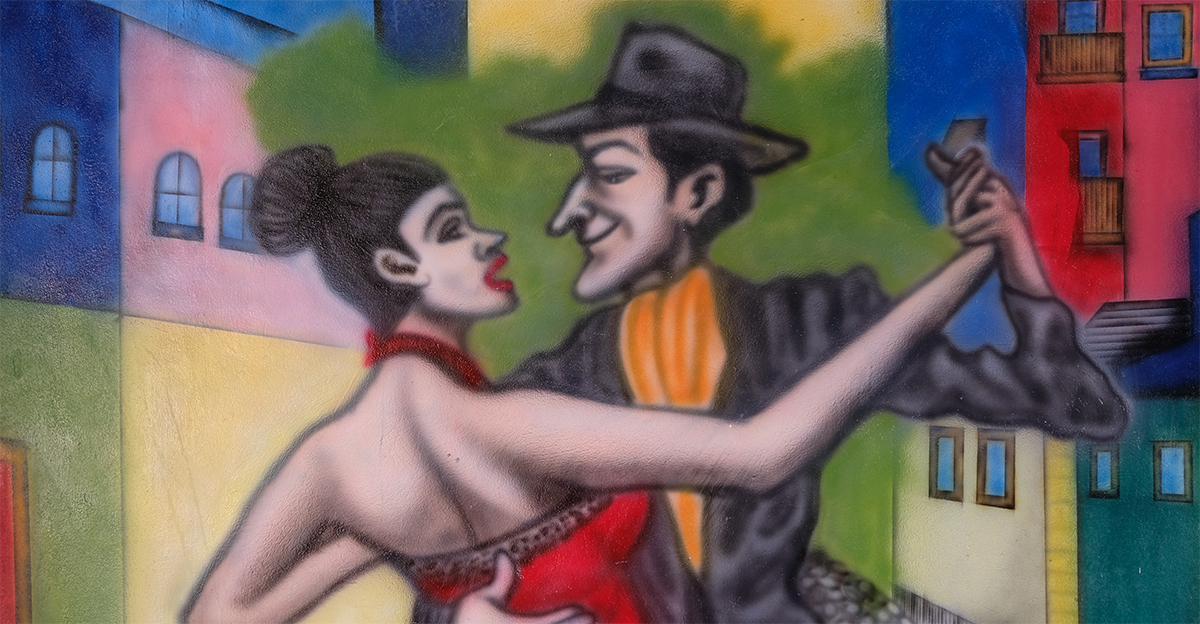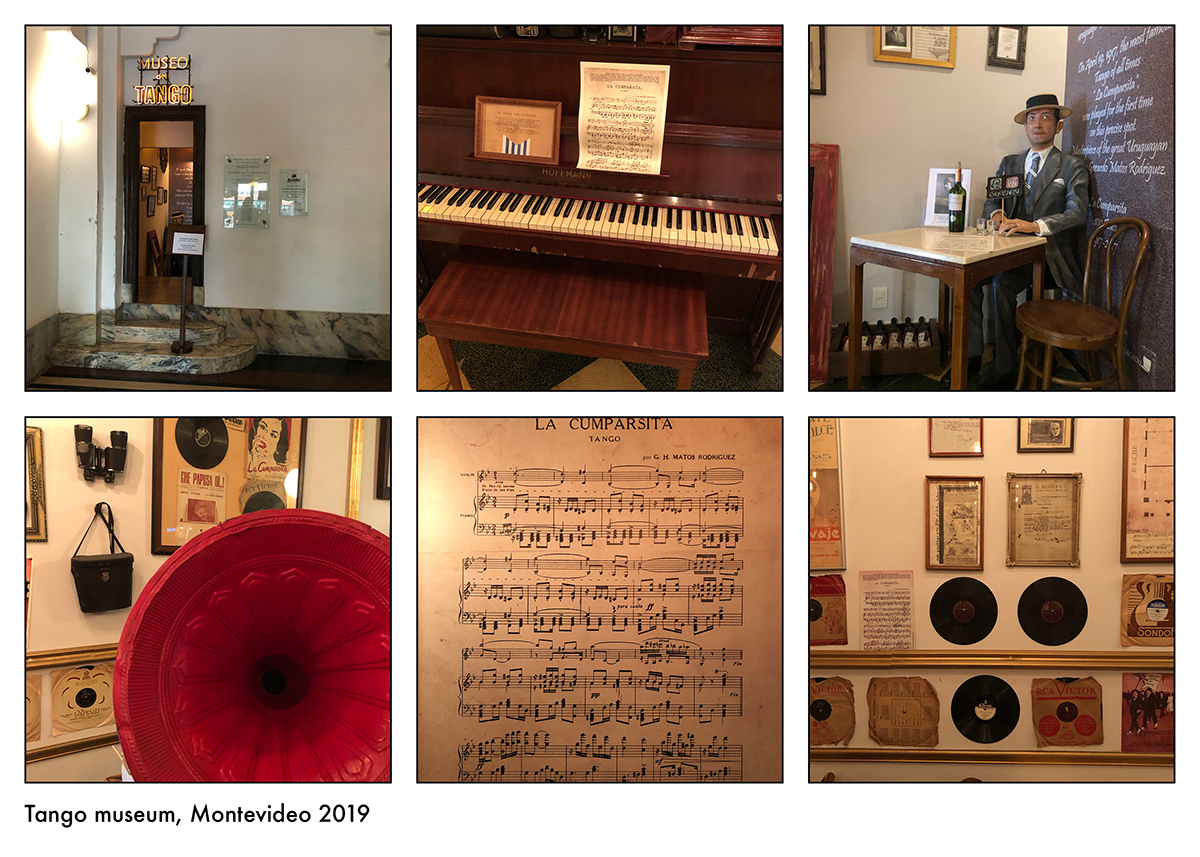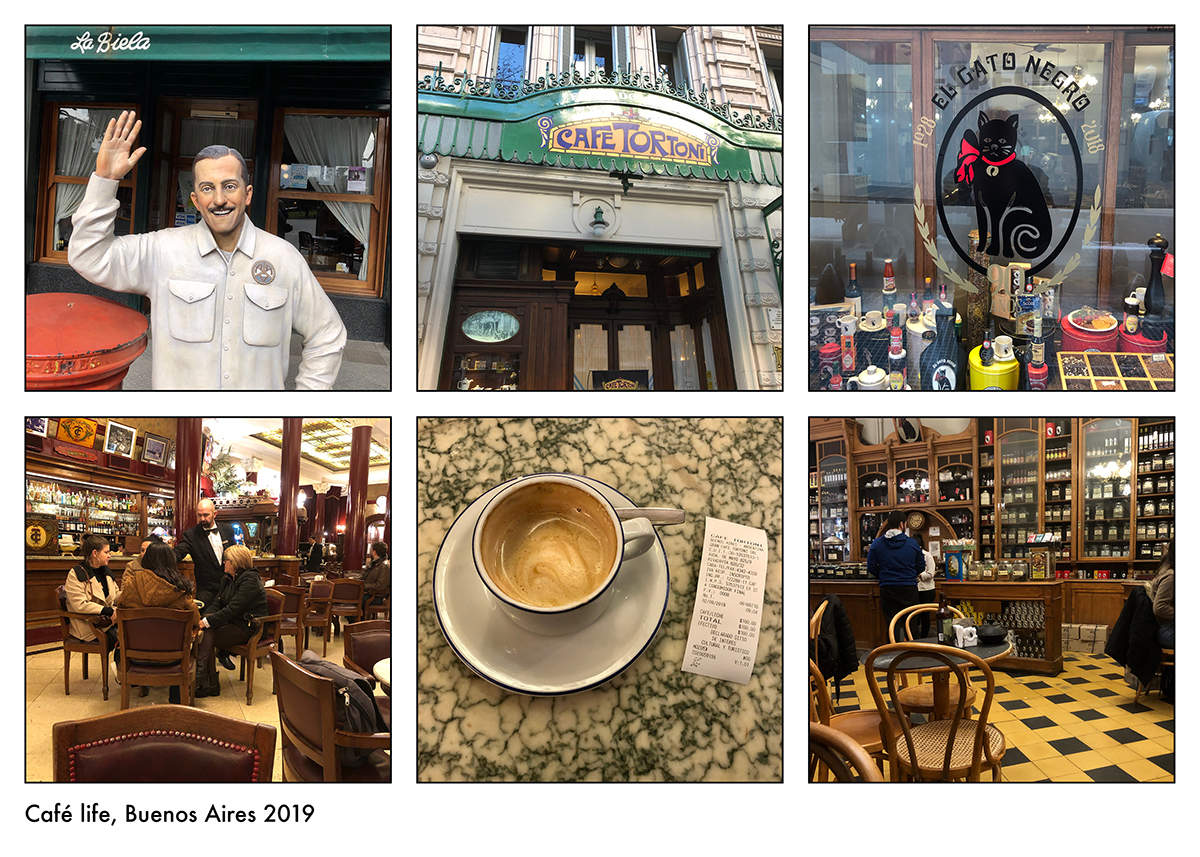Tales of two cities
Tango is known worldwide as an Argentinian dance and music form, but it is as much an important part of the Uruguayan identity. The famous composition La Cumparsita from 1917 by the Uruguayan composer Gerardo Matos Rodriguez is recorded in more than 2000 versions around the world – second only to Yesterday by Lennon/McCartney according to the museum guide at the Museo de Tango in Montevideo. It is regarded as the anthem of tango, still according to the museum guide.
An original recording from the 1940-ies can be heard in the museum, which is located in the tallest building in Montevideo, Palacio Salvio, completed in 1935. Before the palace was erected, the premises housed a bar and tango dance hall where only men were allowed. The museum tells you the background and history of the tango, which originally started as a fight and developed into a dance.
The building itself, begun in 1925 and completed ten years later, was erected by an Italian immigrant family and is now housing offices, apartments – and the tango museum. In its early days the building caused controversy, was called ugly, and the internationally well know Swiss architect Le Corbusier apparently had asked for it to be bombed by canons. So said the guide.
I don’t know why, but ever since I was quite young, I’ve always wanted to visit Montevideo. Now I’m here. I arrived in the afternoon on a short flight from the Paraguayan capital on a Bolivian airline called Amaszonas. It left 20 minutes ahead of schedule and arrived 40 minutes earlier than estimated. All well. Until the taxi bill from the airport appeared: 1780 pesos, or more than fifty dollars.
The full official name of the city is La Ciudad de San Felipe del Puerto de Montevideo. For obvious reasons, everyone uses the abbreviated name. Montevideo streets are alive, even in mid-winter, and they dance tango here too, as the sun is about to set. So, what to see in Montevideo, as both the mercury and the clouds are low? Buildings and museums, Google says, and I start researching what might be of interest. A lot of interesting spots are located near Plaza Independencia and along Avenida 18 de Julio. 18th of July is the date of the Constitution from 1830 and the national day in Uruguay, incidentally on the same date as Adolf Hitler publishes his infamous “Mein Kampf” in 1925. As I am up for breakfast at seven every morning, there is time for good research ahead of the sightseeing of the day. Most things only open at 10 am. As more than an average photography enthusiast, the Centro de Fotografia de Montevideo, will have the honour of my visit.
What I knew and what I did not know about Montevideo:Montevideo hosted all the matches during the first FIFA World Cup in 1932.
Montevideo has consistently been rated as having the highest quality of life of any city in Latin America: by 2015 has held this rank every year during the last decade. As of 2010, Montevideo was the 19th largest city economy in the continent and 9th highest income earner among major cities.According to 10 Best, in 2006 the Mercer Human Resource Consulting firm named Montevideo the Latin American city with the best quality of life
Montevideo is the seat of the administrative headquarters of Mercosur and ALADI, Latin America’s leading trade blocs, position that entailed comparisons to the role of Brussels in Europe
Ranked second among American countries in freedom of speech according to Reporters sans Frontier “Reporters without Borders” – after Canada.
More tango, plus cafes and the cemetery: On to Buenos Aires, which is a short boat ride across the estuary of River de la Plata. Smells, colours, and textures accompanied by a good cup of coffee, can always be found in the cafes and bars of Buenos Aires. Some of them, actually quite of few of them, also have a history to tell. The day I arrived I walked the half a mile from my hotel Tango del Mayo to Café Tortoni for an afternoon café con leche. It’s maybe one of the most famous and popular of them all, located on Avenida de Mayo and inaugurated in 1858. But alas, upon arriving there was a long queue outside with people waiting to get inside. I had to settle for something less historical.
If you are of the literary inclined, then there is La Biela next to the well-known Recoleta cemetery, which had noted visitors like Jorge Luis Borges, Adolfo Bioy Casares, and Silvina Ocampo, it is said. Another one is El Federal, the first restaurant in Buenos Aires, which opened in 1864 in the neighbourhood of San Telmo. Café Gato Negro (the black cat) is another one, upon entering you are transcended by the smells of herbs and tea leaves and the colours of the place. And not to forget Café de Los Angelitos, today one of the most iconic places to sit down for a cup of coffee. Voted the most notable café in Buenos Aires in 2017 by 19,000 voters. And there are many others. 36 cafes are listed on a board in Museo Mundial de Tango in Buenos Aires as of interest to those with an eye on tango. But how many cups of coffee can I drink in a day?
According to Wikipedia Buenos Aires in the 1930s was known as the "Paris of South America". The centre of the city had many cafés, restaurants, theatres, movie houses, shops, and bustling crowds. In direct contrast, the 1930s were also years of great unemployment, poverty and hunger in the capital, and many new arrivals from the interior were forced to live in tenements, boarding houses and in outlying shanties that became known as villas miserias.
Tango is one of the most influential and famous dances of the modern history, originating from the streets of the late 19th century Buenos Aires and Montevideo as the favourite dance of the European immigrants, former slaves, and the lower working classes. The quick rise in its popularity enabled this famous dance to quickly expand out of South America, becoming a commonplace in Europe, North America and the rest of the world. With the rich history, numerous types and styles, and incredible appeal, tango still remains as one of the more popular dances in the entire world.
In the 40ies and 50ies tango music became a symbol of physical solidarity in Argentina. Everyone who was in reasonably good physical shape danced tango, and people used tango to stay fit. Today, a traditional alley called Caminito located in La Boca – a former working-class neighbourhood of Buenos Aires – has turned into a street museum. The place acquired cultural significance because it inspired the music for the famous tango "Caminito" (1926), composed by Juan de Dios Filiberto. It was also a close friend of his, the artist Benito Quingquela Martin who lived nearby, who in the early fifties after the railroad closed, painstakingly prepared the walls facing the abandoned street by applying pastel colours. Now the area attracts visitors from around the world.
After walking around among all the visitors I got hungry and entered a slightly shabby Italian restaurant in the area for lunch. It has a charming young man with had that sings Latino love songs, including tango, alternating between inside and outside the eatery. Obviously to attract customers. As with many restaurants in touristy areas, the food is nothing to write home about. The reason for wearing a hat is that he collects tips, as this is his living. Or so he said.
On my last day in the Argentinian capital I left my hotel room at quarter past eight in the morning and had a café con leche at Tortoni. Virtually empty and quiet. The waiters are dressed impeccably with dark trousers, a black jacket, white shirt, and a bow tie. That cannot be said of the customers. At around 9 am it starts filling up. Interestingly the row of tables along the walls got filled up first, and it wasn’t until all these tables were occupied before people took to the tables in the middle of the room. The café cum restaurant opens at eight in the morning, and it celebrated its 160th anniversary last year. It’s well-kept and may well be one of the nicest cafes in the world. Prices were the same as similar establishments.
But no trip to Buenos Aires without visiting Eva Peron – or rather: her grave. She would have turned 100 this year, and among all the 6,400 statues, sarcophagi, coffins, and crypts commemorating some of Argentina’s most celebrated sons and daughters in this labyrinthine city of the dead, hers is one of the most visited. Although she died in 1952, her body wasn’t interred in the Duarte family mausoleum for 20 years. Evita lies in a heavily fortified crypt some five metres underground, to protect her remains.
It is an eerily beautiful and tranquil place, with shadowed walkways and towering marble mausoleums rich in art deco, art nouveau, baroque and neo-gothic architectural styles, masonic symbols and powerful religious iconography. Over 90 of its tombs are listed as national historical monuments. But be there before the crowds.
Every cemetery has a ghost story, and Recoleta is no exception. David Alleno worked for 30 years as a cemetery gravedigger, carefully saving his money for his own plot and a statue of himself, I have read somewhere on the net. It is said that as soon as the architect he had commissioned for the statue had finished the work, Alleno went home and killed himself. Apparently, you can still hear his keys jangling as his ghost walks the cemetery’s narrow pathways at dawn. Also look out for the mausoleum of Liliana Crociati, who died on her honeymoon in Austria in the 1970s. Her parents reconstructed her bedroom within her tomb, and at the entrance placed a bronze statue of Liliana in her wedding dress, with her beloved pet dog at her side.
[August 2019]



